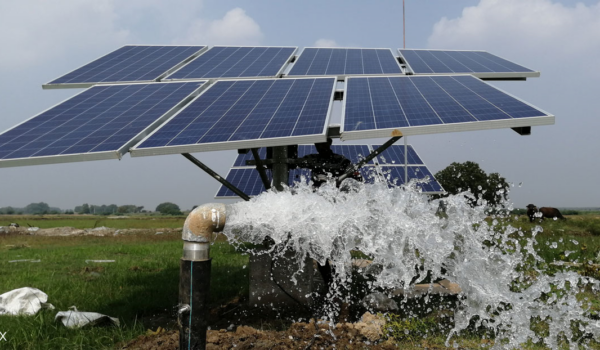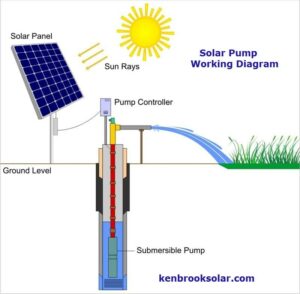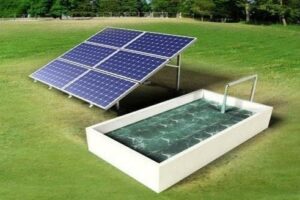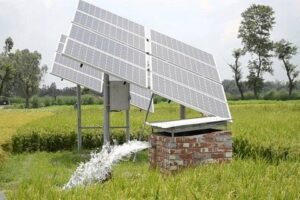Solar Water Pump

A solar water pump is an innovative technology water lifting system that is powered by solar energy. It is also known as Solar Pumping System, Solar Submersible Pump, and Solar Pump. This system typically consists of a solar panel, solar inverter, controller, and sometimes a solar battery. These pumps are more economical since they don’t need grid electricity and reduce carbon footprints too.
The solar-powered pump is a wonderful technique for providing water to isolated locations that are both environmentally and socially beneficial. Solar pumps are more popular among farmers and are used to irrigate agricultural land and horticultural fields. But now, these pumps are increasingly used for fountains, swimming pool pumps, water circulation pumps, mono-block home pumps, and other similar applications.
There are 2 types of solar water pump that are available in various technologies, so it’s worth spending 10 minutes reading the below given information and selecting the best that meet all your requirements.
How Solar Pump Works?

The working of the solar pump starts with the solar panel. Solar panels are made up of a bunch of small silicon solar cells that absorb the sunlight and convert it into DC electricity, which powers the pump. The solar pump directly connects with the solar panel through an MPPT solar pump controller. So whenever sunlight hits the solar panel and you turn the pump on, it starts to lift the water.
In case you are using an AC water pump, then the generated electricity will pass through the solar inverter. Therefore, you will have to install a solar inverter with your solar pump. The inverter will convert the DC electricity into AC electricity and then transferred it to the pump.
Types of Solar Water Pump :
Advancement in the field of solar has led to the development of technologies and types of every solar product. Similarly, if we talk about the types of solar water pumps, then they are mainly of 2 types. Let’s know about these types in brief.
Solar submersible pumps are used where water has to be lifted from deeper underground. If put in simple words, this pump is used to lift water from a depth of more than 15 meters. To lift the water, simply put the pump inside the water and switch it on, the rest of the work will be done by the solar itself. Solar submersible water pumps are the most preferable pumps in India as the water depth is very high in maximum areas.
Surface pumps are relatively small but powerful water pumps. They are used to lift shallow water. If the depth of water is 15 meters or less than 15 meters then a solar surface pump is recommended. It can easily lift the water to the ground or above the ground level. You will find this type of pump pulling water from streams, storage tanks, shallow wells, and ponds at many places.
Solar Water Pump Price :
Types, technologies and capacities are several factors that effects the prices of solar water pumps. We have mentioned the average price list of DC and AC water pumps below.
Solar Water Pump Technologies
There are three technologies to power your solar surface water pump (AC & DC) and solar submersible water pump (AC & DC). A brief description of these technologies is mentioned below
On-Grid Solar Pump
In an on-grid solar system, your water pump will be powered by a solar panel. In case the solar panel is generating more power than the water pump’s consumption, then the excess power will automatically be exported to the grid via net metering and the government will adjust it in your next electricity bill.
Hybrid Solar Pump
In an on-grid solar system, your water pump will be powered by a solar panel. In case the solar panel is generating more power than the water pump’s consumption, then the excess power will automatically be exported to the grid via net metering and the government will adjust it in your next electricity bill.
Is a solar battery. In day time your water pump is powered by solar electricity, at night it is powered by the grid and when both (solar power and grid) are not available then it will be powered by a battery.
Advantages :
- Low maintenance/No recurring cost
- Don’t require fuel or batteries
- Work independently without a utility grid
- Can’t be affected by power cuts, low voltage
- Free of single-phase problems or motor burning
- Beneficial for rural areas where electricity is not available
- No lubricants, so no chances of soil contamination
- Easy to install and operate
- 25 to 30 years long working life.
Disadvantages :
- Require one-time heavy investment


